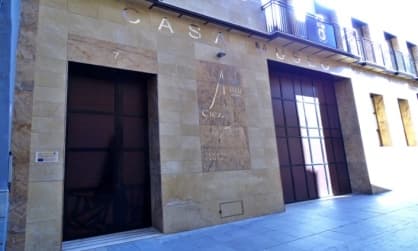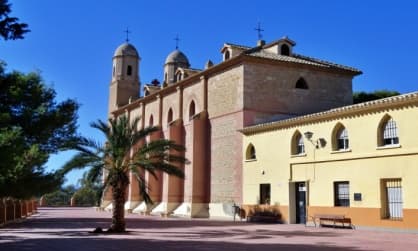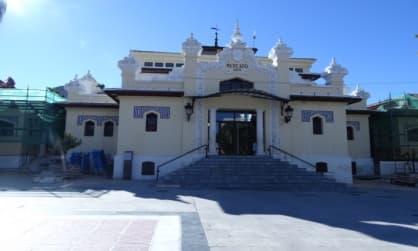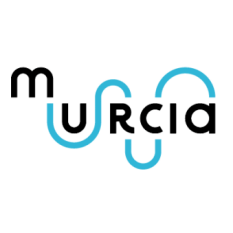
What to see in Cieza
Basilica of the Assumption

It is a building composed of three naves. Its central nave was rebuilt in the 18th century, over a previous church dating from the 15th century. In 1942, the construction of the foundations of what is now the Basilica began. It was consecrated as such by Bishop Astorga and Jesús Mérida from Cieza, on May 3, 1946.
It boasts a neo-Romanesque bell tower, built at the end of the 19th century, the work of which is by the Murcian architect José Marín Baldó, and a 42-meter-high facade with beautiful Rococo-style graffito.
It boasts a neo-Romanesque bell tower, built at the end of the 19th century, the work of which is by the Murcian architect José Marín Baldó, and a 42-meter-high facade with beautiful Rococo-style graffito.
Balcony of the Wall

This is a historical complex made up of a fortress dating from the 15th century, ordered to be built by the Order of Santiago. The current wall dates from 1898. It was the site of a series of events with great historical importance, such as the bloody incursion that was carried out in Cieza by Abu-I-Hassan and his troops from Granada, on April 6, 1477.
It is an ideal free access place to appreciate nature and a wide panoramic view of the entire area of the valley and Segura river.
It is an ideal free access place to appreciate nature and a wide panoramic view of the entire area of the valley and Segura river.
Casa Holy Week House Museum

This was built in 1970 and houses a large part of the heritage of the Holy Week Brotherhoods of Cieza.
We find lanterns, thrones, banners, costumes, etc. On the upper floor, we find the dependencies of the different Brotherhoods, as well as the Meeting and Exhibition Room, where you can see written and graphic documentation of a historical nature regarding Holy Week in Cieza.
We find lanterns, thrones, banners, costumes, etc. On the upper floor, we find the dependencies of the different Brotherhoods, as well as the Meeting and Exhibition Room, where you can see written and graphic documentation of a historical nature regarding Holy Week in Cieza.
Folklore Interpretation Centre
This is one of the scenarios of maximum exposure of the culture of the region. It is designed to publicize the exhibitions on the traditions and ways of life of the municipality that have been lost with the passage of time, due to modernization and industrialization.
Here, the traditional folkloric manifestations such as music, dance, song and costumes, take place, shown in the first room of the place.
Here, the traditional folkloric manifestations such as music, dance, song and costumes, take place, shown in the first room of the place.
This is achieved through the recreation of a traditional home that houses original equipment and furniture, representing the old trades that were once part of the work of the huertanos of the 18th and 19th centuries.
Holy Christ of Consolation Hermitage

Built in the 19th century, on the original Hermitage of Good Success, this is an imposing enclosure that exhibits a neo-Gothic Mudejar style.
It consists of a single nave with small chapels between the buttresses.
In its interior are slender purple arches as decoration; outside, we find a pair of towers that guard the entrance and can be seen in the distance.
It consists of a single nave with small chapels between the buttresses.
In its interior are slender purple arches as decoration; outside, we find a pair of towers that guard the entrance and can be seen in the distance.
The enclosure was definitively restored in 1991, after deteriorating due to the passage of time and the Spanish Civil War.
Food Market

This was built by the architect Julio Carrilero between 1927 and 1929 and was inaugurated on the day of the Cross. It has an ecclesiastical tendency, with a facade loaded with different plaster figures where the decorations based on garlands and plant elements stand out.
It is located in Spain Square, where the artisanal “Mercadillo de Los Frailes” is held, present on the first Sunday of each month, between the months of October and May.
It is located in Spain Square, where the artisanal “Mercadillo de Los Frailes” is held, present on the first Sunday of each month, between the months of October and May.
Siyâsa Museum
This is located in a 19th-century building with a clear modernist style. It was completely renovated and inaugurated on May 2, 1999, as a result of a merger between the old Museum of Saint Bartholomew and the Archaeology Museum.
It is currently an iconic centre for local culture, as it protects important archaeological pieces from various cultures, in addition to being the setting of various temporary and permanent exhibitions.
It is currently an iconic centre for local culture, as it protects important archaeological pieces from various cultures, in addition to being the setting of various temporary and permanent exhibitions.
In this place, we find archaeological pieces from different historical periods: cave paintings, Iberian settlements, Roman remains and two models of the city of Siyâsa.
Teodoro Mill Museum

Built in the 15th century (1506) on the outskirts of the city, this is where the flour mill is housed, whose first name was “Molino de los Regidores Perpetuos”, restored between 1998 and 1999. Its name is in honour of its last owner and miller.
Rectangular with two floors and a semi-basement, the first floor was used as a home, while the second was the mill.
It has a polychrome facade in bright blue and orange.
Rectangular with two floors and a semi-basement, the first floor was used as a home, while the second was the mill.
It has a polychrome facade in bright blue and orange.
Esparto Museum

Inaugurated in the 21st century (2014) and preceded by the Small Esparto Museum created in 2000, it exhibits the long history of Esparto, an austere plant used by man to make all kinds of tools since ancient times, and the evolution in its exploitation.
Here, we find the spaces and the conservation of a series of objects used in the factories, such as the iron sticks used at the start of the plant and the most complex machines for chopping or raking. Photographs are shown, as well as products already made.
Here, we find the spaces and the conservation of a series of objects used in the factories, such as the iron sticks used at the start of the plant and the most complex machines for chopping or raking. Photographs are shown, as well as products already made.
Museum of the Brotherhood of the “Oración del Huerto y Santo Sepulcro”

Its construction dates from the end of the 20th century and it is a place of great importance for the local culture.
Inside we can find, on one of the floors, a permanent exhibition of photographs, sketches and multiple religious representations, as well as the boardroom of the institution.
It has accessibility to the public only on the ground floor, where the steps of the brotherhood receive us.
Inside we can find, on one of the floors, a permanent exhibition of photographs, sketches and multiple religious representations, as well as the boardroom of the institution.
It has accessibility to the public only on the ground floor, where the steps of the brotherhood receive us.
Museum of the Royal Brotherhood of Our Lady of Grace and Hope

The premises for the museum was acquired at the end of the 20th century. It is where the throne of its owner, Our Lady of Grace and Hope, receives us – a handcrafted work embossed by the brotherhood.
Also on display is the throne of the Holy Supper, the work of Antonio García Mengual and Noguera Pastor.
In addition, it is the setting for the exhibition of the premises' own belongings, as well as a collection of photographs.
Also on display is the throne of the Holy Supper, the work of Antonio García Mengual and Noguera Pastor.
In addition, it is the setting for the exhibition of the premises' own belongings, as well as a collection of photographs.
Paseo de Cieza

This was built in the 19th century (1887) by the artist José Lucas, in honour of Diego de Marín, deputy of the courts. After the Spanish Civil War, it was renamed “Paseo de los Mártires”. It was moved in 1986.
It is one of the busiest areas of the city, with approximately 600 square meters, with 17 ceramic murals inserted in the floor and 30 columns designed with the same material, where tradition is contrasted with multi-coloured modernism.
It is one of the busiest areas of the city, with approximately 600 square meters, with 17 ceramic murals inserted in the floor and 30 columns designed with the same material, where tradition is contrasted with multi-coloured modernism.
What to see in the Vega Alta del Segura












